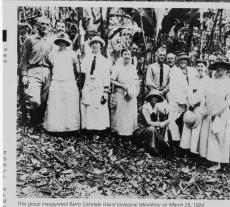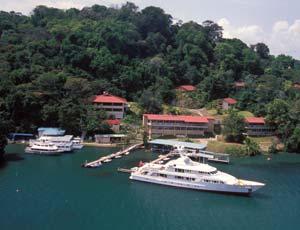 On August 15, 1914, the cargo ship S.S. Ancon made the first official transit of the Panama Canal from the Atlantic to the Pacific Ocean. The Ancon rose through the locks to Gatun Lake and then on through the Culebra Cut to the Pacific. Although a great celebration had been planned, the outbreak of war in Europe that same month made this first crossing a quiet and austere affair.
On August 15, 1914, the cargo ship S.S. Ancon made the first official transit of the Panama Canal from the Atlantic to the Pacific Ocean. The Ancon rose through the locks to Gatun Lake and then on through the Culebra Cut to the Pacific. Although a great celebration had been planned, the outbreak of war in Europe that same month made this first crossing a quiet and austere affair.
The Panama Canal was not just a great engineering feat or major event in the history of world commerce, it was also a major environmental disruption – potentially mixing the waters of the two oceans, allowing species to invade new regions, creating new lakes and waterways, and destroying human and natural environments. Panamanians were resettled from the Canal Zone, forests were felled as regions were flooded to create the canal watershed, and massive campaigns to destroy insect life were launched to limit the spread of insect-borne diseases.
 Smithsonian naturalists at the U. S. National Museum (now the National Museum of Natural History), government scientists, and many of their colleagues at museums and colleges across the United States were concerned about the environmental impact of the canal construction. Thus the Smithsonian led the Biological Survey of the Panama Canal Zone from 1910 to 1912, to establish a baseline of what animals and plants were native to the region and to document environmental conditions, such as weather, soil types, etc. To secure funds for the survey, they turned to an old friend of the Smithsonian, President Teddy Roosevelt, who had started donating natural history specimens when he was a boy, had supported the construction of a new National Museum building, now known as the Natural History Museum, and encouraged the Smithsonian to acquire the Freer Gallery of Art. Roosevelt laid the groundwork for U. S. federal government support, although he had left office by the time the survey began. With federal and private funding, from 1910 to 1914, North American naturalists surveyed the natural world and collected specimens for the National Museum.
Smithsonian naturalists at the U. S. National Museum (now the National Museum of Natural History), government scientists, and many of their colleagues at museums and colleges across the United States were concerned about the environmental impact of the canal construction. Thus the Smithsonian led the Biological Survey of the Panama Canal Zone from 1910 to 1912, to establish a baseline of what animals and plants were native to the region and to document environmental conditions, such as weather, soil types, etc. To secure funds for the survey, they turned to an old friend of the Smithsonian, President Teddy Roosevelt, who had started donating natural history specimens when he was a boy, had supported the construction of a new National Museum building, now known as the Natural History Museum, and encouraged the Smithsonian to acquire the Freer Gallery of Art. Roosevelt laid the groundwork for U. S. federal government support, although he had left office by the time the survey began. With federal and private funding, from 1910 to 1914, North American naturalists surveyed the natural world and collected specimens for the National Museum.
 Although the original plan was to survey the Canal Zone, naturalists soon realized they needed to survey the entire region to determine the geographic distribution of plants and animals. Field naturalists such as Edward A. Goldman of the Bureau of Biological Survey and Albert S. Hitchcock of the Smithsonian’s National Museum explored swamps, cloud forests, bat-filled caves, arid mountainsides, rural farmlands – all of the diverse environments they found in the small nation. The explorers carefully documented the specimens they collected, noting soil conditions, the plants and animals a particular species interacted with, and the geographic range and density of populations. They began regular monitoring of weather and other physical conditions, a program that continues today.
Although the original plan was to survey the Canal Zone, naturalists soon realized they needed to survey the entire region to determine the geographic distribution of plants and animals. Field naturalists such as Edward A. Goldman of the Bureau of Biological Survey and Albert S. Hitchcock of the Smithsonian’s National Museum explored swamps, cloud forests, bat-filled caves, arid mountainsides, rural farmlands – all of the diverse environments they found in the small nation. The explorers carefully documented the specimens they collected, noting soil conditions, the plants and animals a particular species interacted with, and the geographic range and density of populations. They began regular monitoring of weather and other physical conditions, a program that continues today.
 When the Canal opened in August of 1914, the Smithsonian had created a baseline of written information and biological specimens that could be studied to determine the effects of this massive engineering project. Indeed, as the survey ended, the consortium of museums, colleges and research labs agreed to establish a permanent research station so they could continue to observe and learn from the changing dynamics of the region. They selected Barro Colorado Island, a small island that had been a mountaintop before the region had been flooded to create Gatun Lake. They watched as majestic trees turned into waterlogged stumps and large mammals disappeared from the new small island. At the close of World War II, the Barro Colorado Island laboratory was transferred to the Smithsonian’s aegis, known today as the Smithsonian Tropical Research Institute. As the large new locks are constructed today, once again STRI scientists are monitoring changes and conducting salvage field work as the excavations reveal evidence of ancient human, animal, and plant life.
When the Canal opened in August of 1914, the Smithsonian had created a baseline of written information and biological specimens that could be studied to determine the effects of this massive engineering project. Indeed, as the survey ended, the consortium of museums, colleges and research labs agreed to establish a permanent research station so they could continue to observe and learn from the changing dynamics of the region. They selected Barro Colorado Island, a small island that had been a mountaintop before the region had been flooded to create Gatun Lake. They watched as majestic trees turned into waterlogged stumps and large mammals disappeared from the new small island. At the close of World War II, the Barro Colorado Island laboratory was transferred to the Smithsonian’s aegis, known today as the Smithsonian Tropical Research Institute. As the large new locks are constructed today, once again STRI scientists are monitoring changes and conducting salvage field work as the excavations reveal evidence of ancient human, animal, and plant life.
Related Resources
- "1910-1912 Exploration of Panama," Smithsonian Miscellaneous Collections, Biodiversity Heritage Library
- 150 Years of Smithsonian Research in Latin America, online exhibition, Smithsonian Institution Archives
- 1910-1912 Biological Survey of the Panama Canal Zone, National Museum of Natural History
Produced by the Smithsonian Institution Archives. For copyright questions, please see the Terms of Use.


Leave a Comment